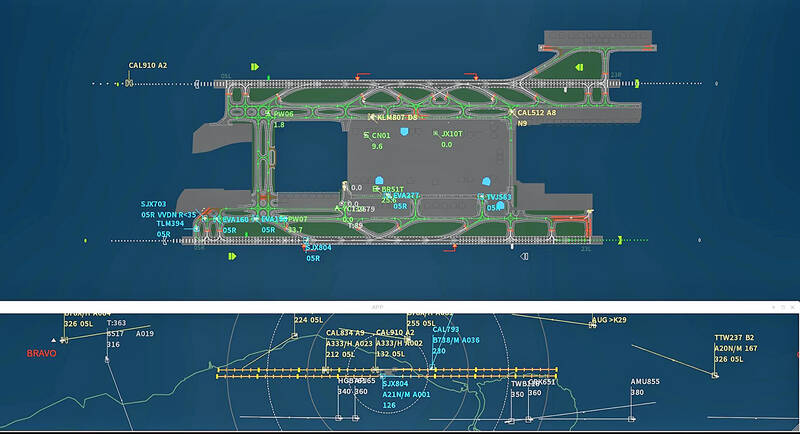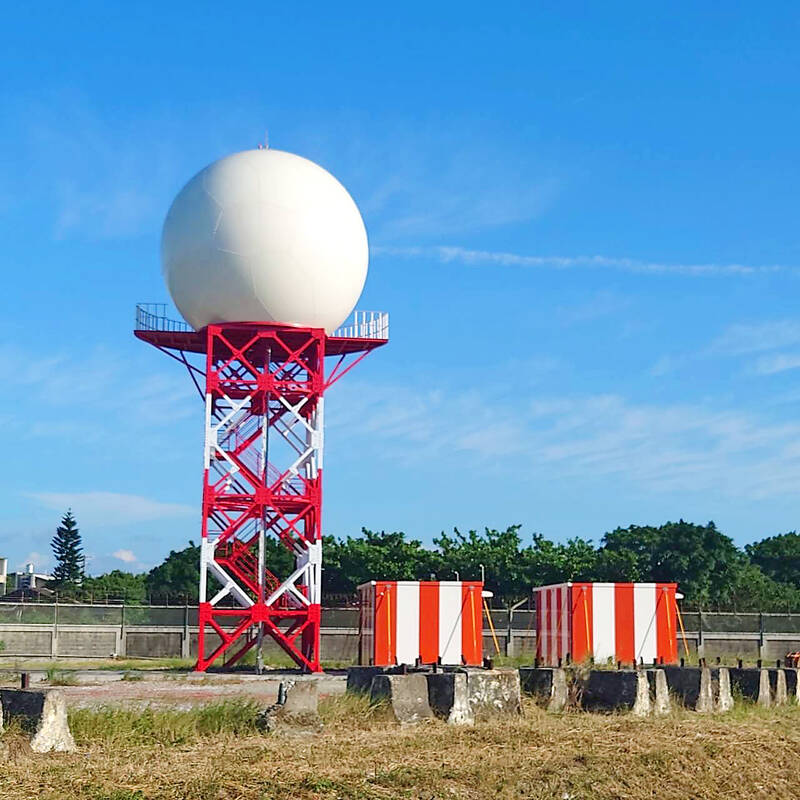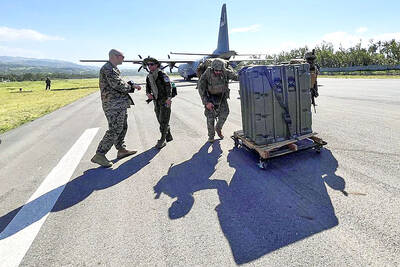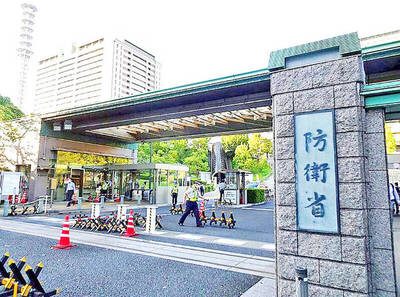A second surface-search radar system has been built at Taiwan Taoyuan International Airport to better detect runway incursions, the Civil Aviation Administration (CAA) said yesterday.
The state-of-the-art system has been installed on the airport’s south runway to detect foreign objects and enable air traffic controllers to monitor aircraft and motor vehicles on the runway and surrounding areas, the agency said.
The first surface-search radar system has been in use at the nation’s largest airport since 2007, the CAA said.

Photo courtesy of the Civil Aviation Administration
However, the number of aircraft using the airport has continued to grow over the past 17 years, creating the need to expand airport facilities, it said.
The second surface-search radar system has increased capacity and covers a larger area to meet demand brought by the third terminal, which is scheduled to be completed in 2026, the agency said.
The new radar system has been integrated with the first radar system and a multipoint positioning system, and has been connected to the automatic system in the control tower, the CAA said, adding that it would reduce the occurrence of runway incursions, decrease delays caused by airport operations and increase the speed at which passengers and cargo pass through the airport.

Photo courtesy of the Civil Aviation Administration
“The development of Taiwan Taoyuan International Airport is key to Taiwan’s civil aviation industry. We need to prepare in advance to ensure that the airport can continue to meet growing demands from passengers and airlines,” CAA Director-General Ho Shu-ping (何淑萍) said. “The new radar system not only increases the safety of the airport’s operations, but offers strong technical support for the third terminal.”
In other news, Ho confirmed that the CAA is considering raising overflight charges that airlines must pay when their flights pass through the Taipei Flight Information Region (FIR).
The agency annually collects about NT$1.9 billion (US$60.33 million) from planes traveling through the Taipei FIR, which covers 18 international aviation routes, Ho said.
“The FIRs near us have adjusted their overflight fees, but we have not changed ours for 17 years, during which time we had purchased new systems and equipment. We will perform a cost analysis and host public hearings on this matter before we announce a new pricing scheme to the public,” she said.
Ho said that the agency’s flight records for the past three weeks showed no abnormality on China’s M503, W122 and W123 flight routes, the use of which China unilaterally changed on Feb. 1.
The M503 route is close to the median line of the Taiwan Strait, while the W122 and W123 routes are close to Taiwan’s outlying Kinmen and Lienchiang counties.

LOOKING NORTH: The base would enhance the military’s awareness of activities in the Bashi Channel, which China Coast Guard ships have been frequenting, an expert said The Philippine Navy on Thursday last week inaugurated a forward operating base in the country’s northern most province of Batanes, which at 185km from Taiwan would be strategically important in a military conflict in the Taiwan Strait. The Philippine Daily Inquirer quoted Northern Luzon Command Commander Lieutenant General Fernyl Buca as saying that the base in Mahatao would bolster the country’s northern defenses and response capabilities. The base is also a response to the “irregular presence this month of armed” of China Coast Guard vessels frequenting the Bashi Channel in the Luzon Strait just south of Taiwan, the paper reported, citing a

A total lunar eclipse, an astronomical event often referred to as a “blood moon,” would be visible to sky watchers in Taiwan starting just before midnight on Sunday night, the Taipei Astronomical Museum said. The phenomenon is also called “blood moon” due to the reddish-orange hue it takes on as the Earth passes directly between the sun and the moon, completely blocking direct sunlight from reaching the lunar surface. The only light is refracted by the Earth’s atmosphere, and its red wavelengths are bent toward the moon, illuminating it in a dramatic crimson light. Describing the event as the most important astronomical phenomenon

ENHANCING DETERRENCE: Stationing the missiles in Kyushu would allow Japan to cover waters near Taiwan and China’s coastal areas without any logistical difficulties Japan is to deploy extended-range anti-ship missiles at a Ground Self-Defense Force base in Kumamoto to bolster its defenses, the Yomiuri Shimbun reported on Saturday. The upgraded Type 12 surface-to-ship missile, with a range of more than 1,000km, would be capable of striking targets in the Taiwan Strait and along China’s coast. Originally limited to a few hundred kilometers, the Type 12 was recently modernized ahead of schedule. Deployment, initially slated for next year, has been accelerated after the upgrade was completed sooner than expected, the newspaper said. Stationing the missiles in Kyushu would allow Japan to cover waters near Taiwan and

The presence of Taiwanese politicians at China’s military parade tomorrow would send the wrong message to Beijing and the international community about Taiwan’s sovereignty and democracy, a national security official said yesterday. China is to hold the parade tomorrow to mark the 80th anniversary of Japan’s surrender in World War II. By bringing together leaders of “anti-West” governments such as Russia, North Korea, Iran and Belarus, the parade aims to project a symbolic image of an alliance that is cohesive and unbending against Western countries, the national security official said, speaking on condition of anonymity. Former Chinese Nationalist Party (KMT) chairwoman Hung Hsiu-chu